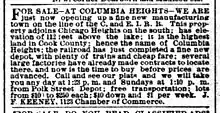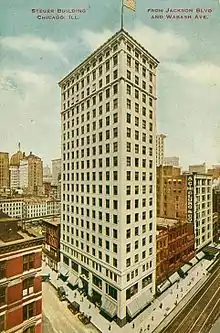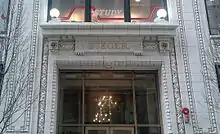Steger, Illinois
Steger is a village that straddles the border which separates Cook County and Will County, Illinois[3] (Steger Road is the border line). It is 35 miles (56 km) south of Chicago and had a population of 9,570 at the 2010 census.[4]
Steger, Illinois | |
|---|---|
.jpg.webp) John Valentine Steger 1854-1916 | |
 Location of Steger in Cook County, Illinois. | |
.svg.png.webp) Location of Illinois in the United States | |
| Coordinates: 41°28′20″N 87°37′04″W | |
| Country | United States |
| State | Illinois |
| Counties | Will, Cook |
| Townships | Bloom (Cook), Crete (Will) |
| Founded | 1896 |
| Government | |
| • Village president | Kenneth A. Peterson, Jr. |
| Area | |
| • Total | 3.40 sq mi (8.82 km2) |
| • Land | 3.40 sq mi (8.82 km2) |
| • Water | 0.00 sq mi (0.00 km2) |
| Elevation | 702 ft (214 m) |
| Population (2010) | |
| • Total | 9,570 |
| • Estimate (2019)[2] | 9,221 |
| • Density | 2,708.87/sq mi (1,045.91/km2) |
| Time zone | UTC-6 (CST) |
| • Summer (DST) | UTC-5 (CDT) |
| ZIP Code(s) | 60475 |
| Area code(s) | 708 |
| FIPS code | 17-72520 |
| Wikimedia Commons | Steger, Illinois |
| Website | villageofsteger |
History



Steger was founded in 1891 by Chicago real estate interests[6] and initially named Columbia Heights in honor of the 1893 World's Columbian Exposition which the City of Chicago had been preparing to host since 1889.[7] The character, financial fortunes and even the name of the community were set immediately thereafter when John Valentine Steger began to build a piano factory there on a parcel of land south of Chicago Heights that was sited immediately west of the Chicago and Eastern Illinois Railroad tracks and bordered by the tracks, Vincennes Avenue (now Chicago Road) and 33rd and 34th Streets. This first building of the complex replaced Steger's original factory which had adjoined his showrooms at Wabash Avenue and Jackson Boulevard in downtown Chicago, which had a capacity of only two pianos per week. This new building was three stories tall, 40 x 225 and designed by the Chicago architectural firm Mayo and Curry to accommodate 200 workers.[8] By 1904 the factory at Steger had grown to cover twenty-three acres and had a capacity of sixteen thousand pianos per year.[9] A piano by the company was displayed at the World's Columbian Exposition, and the instrument was commented on as follows:
Any work dealing with the Piano Industries of this country would be incomplete did it not contain a reference to the celebrated Steger. The particular excellence of the Steger piano consists of its fine quality of tone, seldom found in other high-grade instruments; it is very musical, liquid, round, sufficiently brilliant to satisfy the most fastidious taste. The very finest material obtainable is used in all parts of the Steger, the one aim being to obtain excellence in every feature -- tone, touch, appearance and durability. The name Steger upon the piano is sufficient guarantee of its superior worth.[10]
"The high-grade instrument makers were few, with names like Steger & Sons, Bush & Lane, Baldwin, Mason & Hamlin, Conover-Cable and of course Steinway & Sons. These pianos were among the best of the piano maker's art, instruments intended for artistic and professional use, but also for the drawing-rooms of the wealthy or the aspiring middle-class." [11] The company built exceptionally high quality pianos under several names and in a wide range of prices. They are quite rare today.[12] For a time after 1896, Steger & Sons shared this block with another piano factory which produced instruments for the Smith and Nixon Piano Manufacturing Company of Cincinnati.[13] For years after the community officially changed its name in 1896, Smith and Nixon continued to use the name Columbia Heights when referring to the location of its factory in Illinois.[14] Smith and Nixon were gone from the area by 1911.
Steger was born in Ulm, Germany on March 24, 1854 and had learned the art of cabinetmaking there before coming to the United States in 1871[15] with 12 cents in his pocket.[16] He died on June 11, 1916, after having created over time the largest piano manufactory in the world, which at one time employed 1,400 persons.[17] The Steger family remained active in the community for many years. John's grandson Robert M. Steger was the president of the village's Chamber of Commerce in 1953 and led an ambitious effort that year to work "for a greater Steger" [18]
The Village of Steger was incorporated in 1896 with 324 residents, at which time John Steger agreed to pay $400 toward incorporation costs with the understanding that the town would change its name to Steger, and he subsequently served two terms as the village's board president. He avoided the issues that had plagued George Pullman in his "model town" by encouraging private home ownership and commerce.[19] By 1920, Steger was considered by some to be the "piano capital of the world",[20] producing more than a hundred pianos a day. After changing American tastes diminished the demand for the piano the plant closed its doors in 1928, and the Amico Macaroni Company of Chicago Heights moved into a portion of the vacated building.[21] In 1932 another section of the complex became the home of the Steger Furniture Company,[22] who manufactured radio cabinets there for many years. In 1945, Steger Furniture was acquired by the automobile parts manufacturer Sparton Corporation, who had invented the first electric automobile horn in 1911 and the first all-electric radio after World War I.[23] After a fire, the Steger Piano complex was demolished in the early 1970s.
Steger has been a regular stop on the annual "Driving the Dixie" event from the time it began. The drive involves participants travelling down the historic Dixie Highway in the Chicago Southland and visiting various communities along the way.[24]
Steger advertising & early views
 Advertisement for the Steger Piano Company in 1916 describing the company's connection to the creation of the village
Advertisement for the Steger Piano Company in 1916 describing the company's connection to the creation of the village 1919 advertisement featuring an endorsement by the noted musician Dr. J. Lewis Browne
1919 advertisement featuring an endorsement by the noted musician Dr. J. Lewis Browne 1920 advertisement for a phonograph made by Steger & Sons.
1920 advertisement for a phonograph made by Steger & Sons. c. 1920 image of the fire department
c. 1920 image of the fire department The Eastern Illinois railroad depot, 1917. Passenger service was discontinued from this handsome building in 1971, and it is now fenced in and used for office space and storage.
The Eastern Illinois railroad depot, 1917. Passenger service was discontinued from this handsome building in 1971, and it is now fenced in and used for office space and storage. The residence of George F. Steger. Steger was the son of John Steger, the superintendent of works for Steger & Sons and the president of the Board of Local Improvements for the village of Steger.[25]
The residence of George F. Steger. Steger was the son of John Steger, the superintendent of works for Steger & Sons and the president of the Board of Local Improvements for the village of Steger.[25] Immanuel Lutheran Church. The church was built in 1911, and the stained glass windows that are features of the church today were installed in 1947[26]
Immanuel Lutheran Church. The church was built in 1911, and the stained glass windows that are features of the church today were installed in 1947[26] Columbia School, 1915
Columbia School, 1915 Image of one of the Steger & Sons Mfg. Co. buildings
Image of one of the Steger & Sons Mfg. Co. buildings Image from the roof of the Steger & Sons Building, showing worker's housing outside the plant, c.1915
Image from the roof of the Steger & Sons Building, showing worker's housing outside the plant, c.1915
Geography
Steger is located at 41°28′20″N 87°37′04″W (41.4722472, -87.6177075).[27] According to the 2010 census, Steger has a total area of 3.45 square miles (8.94 km2), all land.[28]
Recreation
Steger has two main parks: Harold Hecht (Fireman's) Park and Veteran's Park.[29]
Demographics
| Historical population | |||
|---|---|---|---|
| Census | Pop. | %± | |
| 1900 | 712 | — | |
| 1910 | 2,161 | 203.5% | |
| 1920 | 2,304 | 6.6% | |
| 1930 | 2,985 | 29.6% | |
| 1940 | 3,369 | 12.9% | |
| 1950 | 4,358 | 29.4% | |
| 1960 | 6,432 | 47.6% | |
| 1970 | 8,104 | 26.0% | |
| 1980 | 9,269 | 14.4% | |
| 1990 | 8,584 | −7.4% | |
| 2000 | 9,682 | 12.8% | |
| 2010 | 9,570 | −1.2% | |
| 2019 (est.) | 9,221 | [2] | −3.6% |
| U.S. Decennial Census[30] | |||
As of the census[31] of 2000, there were 9,682 people, 3,862 households, and 2,506 families residing in the village. The population density was 2,747.3 people per square mile (1,062.0/km2). There were 4,051 housing units at an average density of 1,149.5 per square mile (444.3/km2). The racial makeup of the village was 87.61% White, 6.30% African American, 0.34% Native American, 0.49% Asian, 0.09% Pacific Islander, 3.08% from other races, and 2.10% from two or more races. Hispanic or Latino of any race were 8.07% of the population.
There were 3,862 households, out of which 31.4% had children under the age of 18 living with them, 49.6% were married couples living together, 10.4% had a female householder with no husband present, and 35.1% were non-families. 29.9% of all households were made up of individuals, and 9.7% had someone living alone who was 65 years of age or older. The average household size was 2.51 and the average family size was 3.15.
In the village, the population was spread out, with 25.0% under the age of 18, 9.6% from 18 to 24, 33.1% from 25 to 44, 21.0% from 45 to 64, and 11.3% who were 65 years of age or older. The median age was 34 years. For every 100 females, there were 100.2 males. For every 100 females age 18 and over, there were 98.8 males.
The median income for a household in the village was $43,275, and the median income for a family was $54,347. Males had a median income of $40,598 versus $26,398 for females. The per capita income for the village was $19,816. About 6.0% of families and 8.5% of the population were below the poverty line, including 11.2% of those under age 18 and 5.9% of those age 65 or over.
Government
Steger is divided between two congressional districts. The area in Cook County is in Illinois' 2nd congressional district, while the area in Will County is in the 11th district.
Notable people
- Terry Boers, sports columnist and talk show host
- Luke Butkus, assistant coach for NFL's Jacksonville Jaguars and University of Illinois
- Flora Ciarlo, Illinois state legislator
- Louis Sherman, Steger Mayor (1973-2003) [32]
- Mike Downey, Los Angeles and Chicago newspaper columnist
- Debbie Halvorson, former United States Congresswoman
- John Holecek, linebacker for NFL's Buffalo Bills and San Diego Chargers
- Sal Rocha, Rockford University alumni
References
- "2019 U.S. Gazetteer Files". United States Census Bureau. Retrieved July 14, 2020.
- "Population and Housing Unit Estimates". United States Census Bureau. May 24, 2020. Retrieved May 27, 2020.
- McClellan, Larry A. (2004). The Encyclopedia of Chicago. Chicago: The Chicago Historical Society. p. 783. ISBN 0226310159.
- "Profile of General Population and Housing Characteristics: 2010 Demographic Profile Data (DP-1): Steger village, Illinois". U.S. Census Bureau, American Factfinder. Retrieved March 20, 2013.
- "City of Chicago Landmark Report - Steger Building - 48 E. Jackson Boulevard" (PDF). The Commission on Chicago Landmarks. Retrieved 2015-03-29.
- "Classified advertisement FOR SALE - AT COLUMBIA HEIGHTS". The Chicago Daily Tribune: 19. October 15, 1891.
- Appelbaum, Stanley (1980). The Chicago World's Fair of 1893: A Photographic Record. New York: Dover Publications, Inc. pp. 1. ISBN 048623990X.
- "Among Architects and Builders - The Usual Quantity of Projects for Apartments and Flats". The Chicago Daily Tribune: 28. December 6, 1891.
- "PIANO MAGNATE'S GUESTS AT AN ALL-NIGHT FEAST - Chicago Heights Club Entertains in Honor of John V. Steger's Fiftieth Birthday". The (Chicago) Inter Ocean: 1. March 25, 1904.
- Daniell, Charles A. (1895). Musical Instruments at the World's Columbian Exposition - A Review of Musical Instruments, Publications and Musical Instrument Supplies of All Kinds, Exhibited at the World's Columbian Exposition Held in Chicago, May 1 to October 31, 1893, and the Awards Given for These Exhibits (from All Nations) with the Texts of the Same, Fully Revised. Chicago: Presto Company. p. 303.
- Roell, Craig H. (1989). The Piano in America, 1890-1940. Chapel Hill & London: The University of North Carolina Press. pp. 73-74. ISBN 0-8078-1802-X.
- http://www.antiquepianoshop.com/product/51/steger-sons-parlor-grand-piano/
- "The City in Brief - Recorder Chase's Busy Day - Manufacturing Firm Makes a Purchase in Bloom". The (Chicago) Inter Ocean: 7. February 22, 1896.
- "Display advertisement". The (Greenville, PA) Evening Record: 4. May 2, 1900.
- Stevens, W. W. (1907). Past and Present Will County. Chicago: S. J. Clark Publishing. p. 226.
- "Our Birthdays". The (Chicago) Inter-Ocean: 6. March 24, 1914.
- "Steger, Piano Man, Dead". The (Chicago) Day Book: 8. June 12, 1916.
- "Steger Activities - Third Annual Banquet - Chamber of Commerce to Meet in Steger". The Chicago Heights Star: 14. March 17, 1953.
- Stevenson, William Wallace (1907). Past and Present of Will County. Chicago: S. J. Clarke Publishing Company. p. 236.
- Grossman, James R., Ann Durkin Keating and Janice L. Reiff (2004). The Encyclopedia of Chicago. Chicago: The University of Chicago Press. p. 783. ISBN 0226310159.
- "Steger Residents Will Seek New Source of Steam Supply". The Chicago Heights Star: 1. August 10, 1928.
- Schafer, Frank Ellsworth (April 30, 1935). "Remember - Where are they Now?". The Logansport (Indiana)-Pharos Tribune: 3.
- "Peek Through Time: Jackson's Sparton Corp. a well-known player in several innovative industries". MLive Media Group. Retrieved February 21, 2015.
- Steger, IL
- "Water Supply Mains". The American Contractor: 85. May 7, 1910.
- "Immanuel Evangelical Lutheran Church of the Unaltered Augsburg Confession - Our History". Immanuel Evangelical Lugheran Church. Retrieved February 22, 2015.
- U.S. Geological Survey Geographic Names Information System: Village of Steger, Illinois
- "G001 - Geographic Identifiers - 2010 Census Summary File 1". United States Census Bureau. Archived from the original on 2020-02-13. Retrieved 2015-12-25.
- Storey, Edward H (1961). A Park and Recreation Plan for the Village of Steger, Illinois. Urbana: Recreation and Parks Field Service - The University of Illinois. pp. 21–2.
- "Census of Population and Housing". Census.gov. Retrieved June 4, 2015.
- "U.S. Census website". United States Census Bureau. Retrieved 2008-01-31.
- https://www.chicagotribune.com/suburbs/daily-southtown/ct-sta-former-longtime-steger-mayor-dies-st-0813-20200812-eqiktvxipzct3cjkzkqojekjmu-story.html